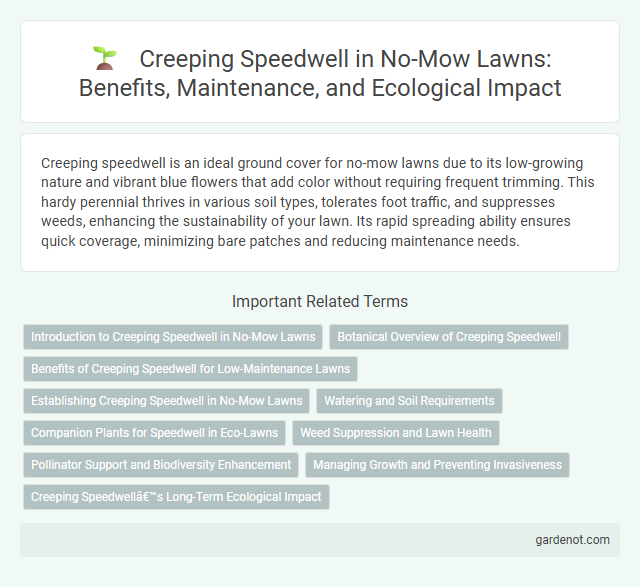Creeping speedwell is an ideal ground cover for no-mow lawns due to its low-growing nature and vibrant blue flowers that add color without requiring frequent trimming. This hardy perennial thrives in various soil types, tolerates foot traffic, and suppresses weeds, enhancing the sustainability of your lawn. Its rapid spreading ability ensures quick coverage, minimizing bare patches and reducing maintenance needs.
Introduction to Creeping Speedwell in No-Mow Lawns
Creeping Speedwell (Veronica filiformis) thrives in no-mow lawns due to its low-growing habit and rapid ground coverage, making it an ideal living mulch. Its small, vibrant blue flowers enhance lawn aesthetics without the need for frequent mowing or extensive maintenance. This hardy perennial tolerates foot traffic and varying soil conditions, promoting durable, eco-friendly turf alternatives.
Botanical Overview of Creeping Speedwell
Creeping Speedwell (Veronica repens) is a low-growing, mat-forming perennial known for its rapid spreading habit and small, oval-shaped leaves. It thrives in well-drained soils and partial shade, producing delicate blue to violet flowers that bloom from spring to early summer. This hardy groundcover is often used in no-mow lawns for its drought tolerance, minimal maintenance, and ability to suppress weeds.
Benefits of Creeping Speedwell for Low-Maintenance Lawns
Creeping Speedwell (Veronica repens) offers significant benefits for low-maintenance lawns, including drought tolerance and resistance to foot traffic, reducing the need for frequent watering and repairs. Its dense, spreading growth habit suppresses weeds effectively, minimizing lawn maintenance and chemical use. This groundcover thrives in various soil conditions while requiring minimal mowing, making it ideal for sustainable, no-mow lawn alternatives.
Establishing Creeping Speedwell in No-Mow Lawns
Establishing Creeping Speedwell in no-mow lawns involves preparing well-drained, moderately fertile soil and sowing seeds in early spring or fall for optimal germination. Maintaining consistent moisture during the initial growth phase enhances root development, ensuring dense ground cover over time. Creeping Speedwell's low-growing habit and tolerance to light foot traffic make it an ideal choice for sustainable, low-maintenance no-mow lawn alternatives.
Watering and Soil Requirements
Creeping speedwell thrives best in well-drained, moderately fertile soils with a pH between 6.0 and 7.5. It requires consistent moisture during establishment but tolerates drought once established, making deep, infrequent watering ideal to encourage strong root growth. Avoid waterlogged conditions to prevent root rot and ensure healthy spread in no-mow lawn areas.
Companion Plants for Speedwell in Eco-Lawns
Creeping speedwell (Veronica filiformis) thrives in eco-lawns alongside low-growing companions such as white clover (Trifolium repens) and creeping thyme (Thymus serpyllum), which enhance soil health and biodiversity. These companion plants create a durable, low-maintenance turf that suppresses weeds, improves nitrogen fixation, and supports pollinators. Integrating creeping speedwell with these species helps maintain a resilient no-mow lawn ecosystem requiring minimal water and fertilizer inputs.
Weed Suppression and Lawn Health
Creeping speedwell enhances weed suppression by forming a dense ground cover that limits sunlight and space for invasive species to establish. This low-growing perennial thrives in no-mow lawns, promoting soil stability and reducing erosion. Its robust growth contributes to overall lawn health by improving biodiversity and resilience against pests and diseases.
Pollinator Support and Biodiversity Enhancement
Creeping speedwell (Veronica filiformis) thrives in no-mow lawns by providing vital nectar sources for pollinators like bees and butterflies, enhancing local biodiversity. Its low-growing habit and extended blooming period create continuous habitat and food supply, supporting a diverse ecosystem. This resilient groundcover promotes ecological balance while reducing maintenance needs in sustainable landscaping.
Managing Growth and Preventing Invasiveness
Creeping speedwell (Veronica filiformis) spreads rapidly through stolons, requiring vigilant management to prevent it from overtaking no-mow lawn areas. Regular trimming and targeted spot treatment with herbicides help control its growth without damaging desirable ground covers. Maintaining healthy turf density reduces open spaces that facilitate creeping speedwell's invasive expansion.
Creeping Speedwell’s Long-Term Ecological Impact
Creeping Speedwell (Veronica repens) contributes to soil stabilization and promotes biodiversity by providing ground cover that supports pollinators over time. Its low-growing, spreading habit reduces erosion and suppresses invasive weeds, enhancing ecosystem resilience in no-mow lawns. Long-term ecological benefits include improved soil health and increased habitat connectivity for beneficial insects.
Creeping speedwell Infographic

 gardenot.com
gardenot.com